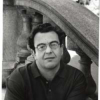Paul Di Filippo

Paul Di Filippo
Paul Di Filippois an American science fiction writer. He is a regular reviewer for print magazines Asimov's Science Fiction, The Magazine of Fantasy and Science Fiction, Science Fiction Eye, The New York Review of Science Fiction, Interzone, and Nova Express, as well as online at Science Fiction Weekly. He is a member of the Turkey City Writer's Workshop. Along with Michael Bishop, Di Filippo has published a series of novels under the pseudonym Philip Lawson...
NationalityAmerican
ProfessionWriter
Date of Birth29 October 1954
CountryUnited States of America
Jeff VanderMeer's fiction has always been entrancingly, engagingly, enthusiastically weird, a winning combination of mimesis and the fantastical that privileges neither component: perhaps the very definition of that mode categorized as the 'New Weird' and exemplified most famously by the groundbreaking work of China Mieville.
The term 'steampunk' itself, now a badge of honor, began as a putdown, a joke. But like 'Big Bang' in cosmology, the diss became the standard.
The sentient beast has long been a staple of fantasy fiction and its antecedents in myth and folktale.
It's a heartening fact about the human race that utopian fiction precedes dystopian fiction in the evolution of literature.
One posthumous measure of a person's life is how often you imagine his impossible return to deal with some event he never lived to encounter. You picture his reactions, his advice, his sage commentary and humorous asides. For instance, I think about Mark Twain's hypothetical take on current events several times a week.
You could engineer a human to survive the greenhouse effect because you think that's what's going to happen, and then all of a sudden the glaciers are creeping down on you.
Science fiction is a literary field crowded with strong opinions, and no SF novelist delivered himself more memorably of his views - on politics, sexuality, religion, and many other contentious topics - than Robert Heinlein.
Of the birth of subgenres, there is no end. They arise like bubbles full of miraculous hopes and potentials from the Planckian foam of the canon, inspiring writers new and established alike.
Generally speaking, by the time a subculture such as steampunk secures the attention of major media, resulting in extensive coverage of the craze, said phenomenon is already on the way out.
More than we sleep, play, or make love, we work. Yet despite - or perhaps because of - this dominant daily grind, much of our literature is biased toward other pursuits.
Just as our solar system has a certain idiosyncratic assortment of planets and moons, different from any neighboring system yet categorically equivalent, so each distinct period of human history might have special qualities and individuals, characteristics and events, yet still be essentially akin beneath the surface to all the others.
The three touchstones that woke Buddha up - sickness, old age, and death - are a pretty good place to start when crafting a tragic tale. And if we need to get more specific: heartbreak, destruction, miscomprehension, natural disasters, betrayal, and the waste of human potential.
Writing one's first novel, getting it sold, and shepherding it through the labyrinths of editing, production, marketing, journalism, and social media is an arduous and nerve-wracking process.
Consensus wisdom has it that all modern commercial fantasy novels fall into two camps: those derived from J.R.R. Tolkien and those derived from Mervyn Peake. The 'Lord of the Rings' template or the 'Gormenghast' mold.